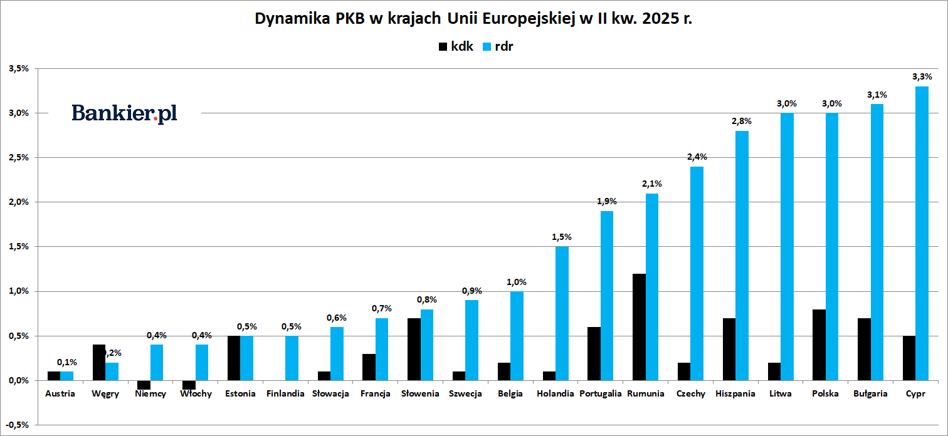EuroGDP: Poland has fallen from its position as Europe's economic leader

The second quarter brought a slowdown to the already slow pace economic growth in the European Union. Moreover, Poland has fallen from its economic position leader in Europe, while maintaining its position on the podium in the EuroGDP ranking.
In the second quarter of 2025, the gross domestic product of the European Union European Union counted as one economy increased by only 0.2% compared to the previous year quarter and was 1.5% higher than a year ago - it was reported on Thursday Eurostat. Quarterly euroGDP dynamics were significantly lower than the previous quarter. ago (when it amounted to 0.5% quarter on quarter) , while the annual dynamics decreased from 1.6% compared to 1.5% recorded in the first quarter.
Despite everything, these results are still better than what we saw in 2022-23 when economic stagnation continued in Europe combined with very high inflation. However, from the beginning of 2024, the data on We could see a slight recovery in GDP, with quarterly dynamics regularly of 0.3-0.6%.
AdvertisementThe data released today was the first "regular" estimated gross domestic product for the second quarter of 2025. Preliminary report for the second quarter we saw at the end of July and indicated it will only lead to minimal economic growth in the eurozone . However, then we had results for many EU countries, including Poland. Now Eurostat has released results for 21 of the 27 EU countries. Only results for Denmark were missing, Greece, Croatia, Latvia, Luxembourg and Malta – mostly small economies.
From what we know, the highest GDP growth was recorded in Ireland, where the economy was supposed to grow by an impressive 16.2% year-on-year. However, it has been known for years that Irish gross domestic product statistics reflect not so much the state of the island economy as the operations tax optimization of global corporations. Hence, Ireland's results can be with a clear conscience skip it.



In this case, Cyprus moved to the top of the EuroGDP ranking, with an annual growth of 3.3%. Bulgaria was second with a real GDP growth of 3.1%. over the last four quarters. Poland tied with 3.0% and Lithuania. But it was our country that recorded the greater quarterly GDP growth, which decides this tie in our favor. It is worth adding that Eurostat presents the results in a seasonally adjusted manner. in Poland it is customary to report the seasonally unadjusted result, which was 3.4%. That's a bit more than Cyprus' seasonally adjusted result. So there's a chance that in the third quarter, Poland will return to the economic throne of the EU.
Among the largest economies in Europe, Spain was the leader, with GDP growth of 0.7% quarter on quarter and 2.8% year on year. This is slightly less than in previous quarters, but still an impressive result by stagnant standards "old Europe". The Italian economy contracted by 0.1% quarter-on-quarter, growing by only 0.4% year-on-year. France's GDP grew by 0.3% quarter-on-quarter and 0.7% year-on-year. In practice, this is stagnation.
But it's still better than in Germany. The GDP of the largest the economy of the Old Continent shrank by 0.1% quarter-on-quarter (after an increase of 0.3% quarter-on-quarter) a quarter earlier), but the annual dynamics remained positive and amounted to 0.4%. Europe's largest economy has been in a structural crisis for several years. economic crisis and forecasts there is no indication that this will change in the near future .
In terms of annual GDP dynamics, they performed worse than Germany. only Hungary (0.2%) and Austria (0.1%). In turn, the decline in GDP relative to previous quarter Eurostat recorded only in Italy and Germany (after -0.1% quarter on quarter). As a result, no EU country experienced a so-called technical recession. recession, i.e. at least two consecutive quarters of GDP decline.

bankier.pl






